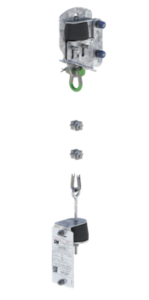
The Climb-Maxx clears obstructions, such as mounts often located at the top of structures, with a wire that stands off four inches from the mounting holes. Additional standoff up to nine inches is available.
To ensure they can be easily inspected, Climb-Maxx wire ropes are designed with visibility to all components so a climber or a drone can easily verify that all of the load path is still there and meets safety standards.
The Differentiator
One of the core differentiators of the Climb-Maxx wire rope safety climb is the attention PerfectVision pays to establishing a proper load path to transfer the weight of the climber to the structure in the event of a fall.
The internal load path of the Climb-Maxx product itself connects to the top attachment, and the load path within that top attachment has to be satisfied. PerfectVision’s approach uses an attenuating device at the top, which is made of thermoplastic elastomer and is UV-rated to withstand the elements.
“One of the inspirations behind the development of the Climb-Maxx wire rope safety climb is establishing a proper load path to ensure the safety of a climber who is falling,” said Scott Stekr, Vice President of Engineering at PerfectVision.

PerfectVision chose a unique method of attaching the Climb-Maxx wire rope safety climb to rung and rails on the tower. It hooks to the rungs near the rails of a vertical ladder, instead of connecting to the center of the ladder rungs. “As a way of ensuring that the load can make it to the foundation, we attach it out to the sides of the ladder. The rails of the ladder are actually a lot stiffer, a lot more rigid than the rungs,” Brenton Barton, Engineer at PerfectVision, said.
TIA Standard 222 is always at the top of mind for the products developed by PerfectVision. When developing Climb-Maxx wire rope safety climb, the engineering team followed Chapter 12 of TIA-222, Rev. H, which covers climbing facilities. Additionally, the equipment meets the requirements of ANSI-ASC A14.3-2018.
Following Industry Safety Trends
To stay up on the latest developments in safety research, PerfectVision reads, and sometimes contributes to, white papers released by the Safety Equipment Manufacturers Committee (SEMC) of NATE, the Communications Industry Contractors Association. The group conducts real-world testing and provides detailed information applicable to the performance of safety equipment and related components utilized within the communications infrastructure industry.
“We follow the SEMC closely to see the tests that they’ve done and the kind of data they’re producing. We make sure that we’re in line with that. We’ve also participated in some of their testing in the past,” said Stekr.
PerfectVision also contributes to the Telecommunications Industry Foundation (TIF) of the Telecommunications Industry Association, which publishes educational white papers and videos for the telecom industry.
TIF white papers and videos have a direct impact, not only on how PerfectVision designs the physical parts, but also on the genesis of the products themselves and the documentation. One white paper produced by TIF focuses on climbing facilities and highlights the roles and responsibilities of various stakeholders that are critical to ensuring properly installed safety climbs. An informational Safety Climb video library that includes the Cilmb-Maxx product is available here:
Click on the VIDEO and scroll down for the Safety Climbs series
“Manufacturers themselves have to provide good documentation on their products for the engineers, so they know what product to use. And then the engineers, themselves, need to produce documentation for the contractors, so they know how to properly install the products,” Stekr said.
Production installation documentation for engineers and installers has traditionally been lumped together, but PerfectVision believes it is better for them to be separate. “We want to have the best of both worlds: one that the engineer can use and another that the contractor can use,” Stekr said.
Safety information provided by organizations such as OSHA, TIF, ANSI, NATE and others provide a wealth of knowledge of safety equipment and PPE. With that knowledge of the risks confronting job site personnel and years of safety equipment manufacturing experience, PerfectVision understands the importance of proper planning, providing, and training of safety equipment and PPE. Furnishing employees with the correct equipment, like the Climb-Maxx wire rope safety climb, should be the number one priority, says PerfectVision.
To access Climb-Maxx installation guidelines and product information, visit CMX.puush.com or contact them at https://www.perfect-vision.com/PartnerwithPV/TelecommunicationsInfrastructureProducts
By J. Sharpe Smith, Inside Towers Technology Editor





Reader Interactions